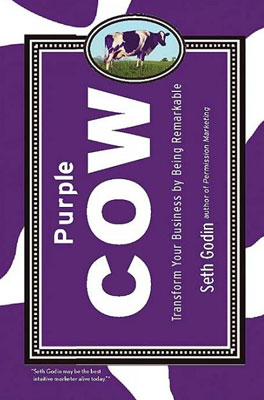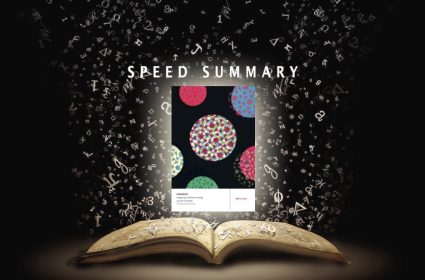Purple Cow Speed Summary

 Purple Cow: Transform Your Business by Being Remarkable
Purple Cow: Transform Your Business by Being Remarkable- Author: Seth Godin
- Publisher: Portfolio
- Publication date: May, 2003
Top Line: Traditional marketing isn’t working anymore. The old virtuous circle of ‘buy ads – get distribution – sell product – buy ads…’ no longer pays. The solution? Stop advertising and start innovating. What you need to build your brand is a remarkable product or service.
Be Remarkable
This cult book on innovation from marketing guru and bestselling author Seth Godin, has a simple message. Be remarkable. Purple Cow argues that the only way to cut the hyper-clutter of products and advertising today is to innovate something new, unique and remarkable – like a purple cow.
Godin points out that 80% of the 30 newest entrants to Interbrand’s top 100 brand list owe their success to word of mouth around what they sell rather advertising clout. Successful brands like IKEA, Starbucks, SAP, Krispy Kreme, Jet Blue, Google are all built on remarkable products that get talked about. Innovation brains, not advertising or distributional muscle is what is needed to succeed in marketing today.
‘Remarkable-ize’ your Brand
Purple Cow is an inspiring self-help book for entrepreneurial marketers who find themselves stewarding big brands where innovation is often no more than me-too copycat cloning. Godin offers practical tips to ‘remarkabalize’ your brand through innovation.
For example, by horizontally integrating innovation – getting stakeholder involvement from the board down to lead buyers – you improve the chances of getting a successful Purple Cow to market. Likewise, by making ‘being remarkable’ a Critical Success Factor for innovation, you get to screen out boring brown cows. Starting up a separate Purple Cow innovation work-stream can free you from the shackles of traditional new product development. And don’t forget to live the Be Remarkable mantra yourself, do one thing worth talking about everyday.
If Purple Cow has a weakness it is that it underestimates the underestimates the power of the Dark Side corporate conservatism. Nobody (yet) got fired for sinking money into advertising sizzle, whether or not there was a (purple) steak worth sizzling in the first place. To remedy this, a follow-up book, ‘The Big Moo’ co-written with Malcolm Gladwell, Tom Peters, and Guy Kawasaki and others, Godin outlines 33 inspiring ideas for remarkabalizing your brand (Amazon link).
But if you’re interested in firing up the corporate barbeque for your company now, and want a purple steak to sizzle, we’ve put together a Purple Cow brainstorm for you based on the 30 key points and recommendations made in the book.
- Start by making a simple consumer wish list. Are there any gaps you could fill between what people want and what they’re getting today?
- Think about the current leader in your market – if you could change just one think about it in order to make it more remarkable, what would that be?
- Infectious products are a) easy to try and buy, b) easy to recommend, c) for a defined community, and d) part of a trend (rather than a fad). How would you tweak what you currently sell to make it more infectious?
- Focus on the two key groups who will drive your sales – highly profitable buyers, and opinion leading buyers. What would you have to do to make what you sell remarkable to them?
- Make a list of competitors who not trying to be all things to all people, can you find another underserved niche to target?
- Think about what the market leader is doing, then focus on doing the opposite.
- Imagine you gave your innovation brief to a world class designer, what would they do different?
- Make two lists, one of the top reasons to recommend products in your market and the other of top reasons not to recommend. Can you spot any opportunities?
- The opposite of remarkable is very good (because very good is bland), what would you do to turn a very good product into a truly remarkable product?
- Packaging can make a product, and remarkable packaging can make a product remarkable. Think about remarkable packing – what can you do to make packaging remarkable?
- If you were going to make a parody or spoof of your product, what would it look like? This will give you a clue to what could be remarkable about your product.
- Imagine you are making a highly exclusive limited edition of your product for your 20 best customers – what would that be?
- What would you do if you wanted to make a collectable version of your product?
- Forget demographics for a minute – list the big social networks and communities in your market (associations, clubs, employers, institutions). Could you make a special edition of your product for one of these networks or communities?
- Remember that convenience is king – what could you do to make buying, using, consuming, or disposing easier?
- Take another look at the top ‘reasons to recommend’ in your market; these are what make products remarkable. What could you do to own one of these reasons to recommend?
- Your business card is your product in print – and is a big part of what you sell, what could you change about business card to make it more remarkable
- Imagine you’ve woken up as a maverick, with no respect for the company way of doing things today – what the first thing you’d change about your product?
- List all the customer suggestions and customer complaints you’ve heard, what could you do to address them?
- Think about products in your market with remarkable design – what would you do to make the design of your product worth talking about?
- Who currently makes the most remarkable products in your industry? What would they do if they were in your shoes to make your product more remarkable?
- Imagine you are your most loyal customer advocate – what could you do to make them rave even more about your product
- List the things that people find remarkable about products in your target market. If you wanted to own what is remarkable, what would you have to do?
- Remarkable products are often controversial and outrageous – what would a really controversial or outrageous version of your product look like?
- Try brainstorming with no marketing terms or jargon – it gets in the way of clear thinking about making remarkable products.
- Think of ways you could build a competitor to your own product with costs 30% lower? If you could, why don’t you?
- Imagine your product is a person, and you have to write a job reference for them – what’s worth recommending and what isn’t?
- Sticking with the ‘imagine your product is a person’ theme, what advice would you give them to help them get a job?
- Explore limits – what would you do to make yourself the cheapest, most expensive, the biggest, the smallest, the fastest, the slowest, the newest, the oldest
- Finally, imagine you are someone who loves taking risks – what’s the one really risky thing you would do to make your product better?




